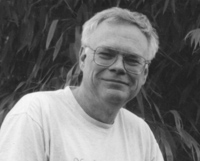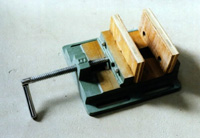- Details
-
Created: Friday, 02 March 2001 06:09
Sculpture is a field that constantly questions itself: in what manner does art occupy the same space as the everyday world; what is a work of art; what is the meaning behind abstraction; how does it affect us? Sculpture concerns itself with space, with the experience of a void, and with capturing a spirit beyond the visible. -David Haslett
Upon finishing my slide presentation on Art and Architecture in France at the Camp Brotherhood Symposium 2000, Rich Hestekind asked me how the month long trip to France had influenced my creative inspiration. Good question.
After spending a month in France, the first thing for me was putting the overwhelming amount of history into context. The volume of handwork, hard precise work, did indeed leave a lasting impression. Plain and simple it’s pretty hard to miss massive towering cathedrals, all the stone and bronze sculpture, and townships wrapped in walls of granite. In the south of France the town of Arles, for example, contains a Roman coliseum built 2,000 years ago and capable of holding 20,000 people. It is still in use today, hosting everything from bull fights to rock concerts.
There are 70 major museums in Paris. Several are what I considered the jewel boxes of the planet, packed full of master artists. Van Gogh, Renoir, Cezanne, Monet, da Vinci, Rodin, Degas, Goya, Ingres, Durer, Botticelli, Raphael, Michelangelo, Vermeer, Titian, Holbein, Delacroix, Courbet, Bourdelle, Manet and more, are all found here. Viewers can find themselves in awe in front of all this strength.
The level of inspiration escalated for me when I went through the Egyptian collection in the Louvre. Standing face to face, literally, with a dozen sarcophagi carved out of black granite, polished to a glass finish made me wonder: just exactly what kinds of tools did they use? Lids carved in full body relief, while under the lids were full body line drawings of that person. Inside the box were full line drawings of the back of the person with detailed celestial coordinates giving the illusion of looking out to infinity.
The Greek, Assyrian and European sculpture collections defy and survive all opposition. Those sculptors built upon permanent and vital laws capturing the illusive secret of form, light and transparent shadow. They speak the universal timeless language – ART. After spending weeks with these heavyweights, one begins to understand far more intelligently what constitutes enduring qualities in art, regardless of dates or tradition.
Our third week found Jan and me in Carnac for five days. Carnac is a small town on the southern coast of Brittany. It is considered to be one of the oldest and most sacred places on earth, where Stone Age Man (SAM) regulated the life force through the study of the Sun, the Moon and the Earth. Different research and opinions date this civilization as far back as 6,000 to 9,000 BC.
These people were very active in moving large stones. The largest stone still standing, is over 33’ above ground and 20’ below, weighing 150 tons. Lightning hit it in the 18th century and dislodged a fragment from the top. The largest stone these people had raised to stand vertically, (which is now in three pieces on the ground), weighed 350 tons. There are several thousand stones found throughout the region; many had been moved anywhere from two to eight miles. The Alignments consist of 1,670 standing stones arranged in 11 rows covering some three miles, all granite. At the west end, the large stones average 16’ above ground and weigh 25 tons, graduating down to about the size of a refrigerator.
Walking the “so-called “ trails out into wooded areas we found dolmens. Dolmens consist of as many as 16 to 24 standing stones that create corridors 6´wide by 6’ high. These stones are then capped with one to six, sometimes a dozen, “lid “ stones, the largest lid weighing 40 tons. Some of these formations were then covered with earth and are called a “tumulus”. Inside one such tumulus were found numerous nephrite ritual “axe-heads“, polished to a glass finish. Considered by some to be dowsing triggers, they were used to locate the placement of stones in SAM earth geometry. Possibly a hundred of these axes are on display in the Carnac museum. When we encountered a large single standing stone far away from the rest, it didn’t seem to make much sense; researching this a bit more I found that the big picture has these menhirs and dolmens arranged up to eight miles in diameter in nearly perfect circles.
Being around these stones raises a lot of questions, and after two days my brain began to lock up. These stones have stood calmly through the centuries unchanged, still giving a feeling of eternal majesty. The function of form in these early searches for expression, had to be based in primal reality: life and death, volcanic eruption, glaciers, earthquakes, floods, eclipses, tornadoes, the changing night sky……. all-present and powerful forces of nature. These occurrences demanded some symbolic form through which humans could offer prayer or in some way express their conception of the infinite. It appears the first basic principle of form was cosmic in its meaning; it was the between the consciousness of a people and the invisible power of the infinite.
People, too, are forces that change the earth. In the relatively short time humankind has been here, most of the “structured” spiritual activity has been represented in stone. Usually the hardest stones. To me, it seems there is a subliminal instruction from the earth’s crust linked directly into our genetic make-up. The stones represent a stimulating and rewarding language and stone carvers are the people who choose to translate this language into art. Understanding the alphabet in order to write new words is where we gain our strength. That is what we artists are here for, to reveal beauty. The studio is our garden. When we crystallize ideas by bringing them into this world we are giving birth to new images, new ideas, new directions.
So, Rich, there’s a long answer to a short question. My creative inspiration is more strongly driven by understanding a little of this area of the planet’s history. It energizes my soul, and fills a need that makes the creative process more important and more complicated than ever. Be bigger than the game and carve proud.
 Q; I have noticed people choosing a stone to carve by tapping the stone and listening. What are they doing?
Q; I have noticed people choosing a stone to carve by tapping the stone and listening. What are they doing?
 When asked by beginning carvers for advice on what type of stone to start with I often go beyond the usual discussion of carving characteristics and suggest a stone big enough that it won’t move when attacked by hammer and point. When working smaller pieces all of us have experienced the frustration of a stone’s skittering across the work surface. Sand bags are a great aid but there are times when what is needed is a good grip.
When asked by beginning carvers for advice on what type of stone to start with I often go beyond the usual discussion of carving characteristics and suggest a stone big enough that it won’t move when attacked by hammer and point. When working smaller pieces all of us have experienced the frustration of a stone’s skittering across the work surface. Sand bags are a great aid but there are times when what is needed is a good grip.
